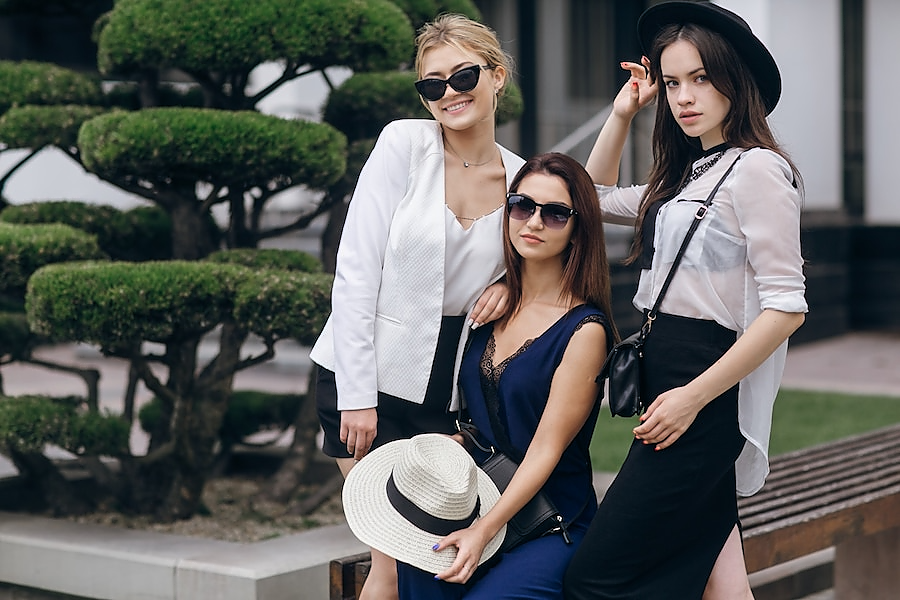What Is Taffeta Fabric? A Complete Guide to Properties of Taffeta, How Taffeta Is Made, and Where It Comes From
When you ask, “What is taffeta fabric?” You’re asking about a textile...
You have an eye for fashion and style. You know how to sketch designs, choose fabrics, and sew amazing outfits. But do your designs sell? Translating your creative concept into items that people desire to buy is an art form in and of itself.
If you want to make money from your clothing line, you have to design with your target customer in mind. You must design clothing that fits well, is of premium quality and current style, and is within your target market’s budget.
This post will review ten suggestions on how to design clothes that sell and look amazing on the shelves. From researching your target market to choosing versatile and flattering styles to using social media to build buzz, these tips will help you create a collection that fashionistas everywhere will be dying to get their hands on.
To be a good clothing designer, focus on 10 clothing design tips:
You need to know exactly who you’re designing for to design clothes that sell. Are you targeting teens, young professionals, or retirees? Pinpoint your customer and their lifestyle, interests, and fashion preferences.
Once you’ve identified your target market, design specifically for them. If it’s teens, focus on trendy, stylish options at an affordable price point. For young professionals, sleek, high-quality pieces that transition from work to play Retirees will likely want comfortable yet put-together clothing.
Consider your customer’s needs, values, and pain points. What will make their lives easier or more stylish? How do I make designer clothes? Address these questions through thoughtful, innovative design.
Pay attention to fit, fabric, and quality. Well-fitting, high-quality clothing that’s comfortable and long-lasting will keep customers coming back. Use soft, breathable fabrics in flattering cuts.
Keep up with the latest styles and trends, but don’t make dramatic changes from season to season. Update classic, versatile pieces to create a cohesive collection that stands the test of time. Your customers will appreciate a signature style they can count on.
Get to know your target market, use these pointers, and create a collection that they will adore. Your clothing will soon be flying off the shelves! Success comes from truly understanding who you’re creating for and why your designs meet their needs. Focus on them, and the sales will follow.
To start designing clothes that sell, you have to consider how they’ll look on all body types. The most common are pear, apple, hourglass, and rectangle shapes.
For pear shapes (bigger hips, smaller up top), draw attention upward with details on the shoulders, neckline, and sleeves—flowy, A-line dresses and skirts that flare out at the hips also flatter pears.
If you’re designing for apple shapes (broader shoulders, bigger bust), aim for balance. V-necks, wrap tops, and belted or tailored pieces are all good options. Empire waists that sit just below the bust help too.
Hourglass gals (curvy up top and down below) look great in clothes that accentuate their narrow waists. Fitted tops, pencil skirts, and belts are perfect for highlighting an hourglass figure.
For rectangle shapes (with a little definition between the waist, hips, and shoulders), add shape and curves. Ruffles, peplum details, and tapered pieces all create shape. Wrap dresses, tops, and jackets also nip in at the waist.
By considering how different shapes will wear your designs, you’ll end up with styles that make more people feel and look their best. That’s a winning recipe for clothes that sell! Focusing on fit and flattering details for multiple body types means your designs will attract a wider range of customers.

When designing clothes, wearability, and versatility are key factors that will make or break your success. Focus on these elements to create pieces that resonate with customers and keep them coming back.
Design clothes that can be worn in multiple ways and for various occasions. Pieces that transition from work to weekend to evening appeal to customers looking to maximize their wardrobe. Consider detachable elements, reversible or multifunctional pieces, and neutral, solid colors that pair well with prints and patterns.
Prioritize pieces that fit well and feel comfortable. Customers won’t buy clothes that don’t flatter them or feel good against their skin. Pay attention to proper sizing, the drape, and the flow of fabrics, and consider stretchy, breathable materials. Don’t forget details like well-placed darts, adjustable closures, and linings that prevent irritation.
Create stylish yet practical pieces that can be easily incorporated into someone’s existing wardrobe. Trendy but extreme styles may attract social media buzz but often lack longevity. Timeless, minimalist designs in classic cuts tend to withstand fashion fads. Add your unique creative flair through subtle details, high-quality materials, or a polished finish.
To design clothes that sell, focus on styles that are currently popular but also have longevity. Riding the coattails of fleeting fads may lead to short-term sales boosts, but timeless styles are what drive consistent revenue.
Follow fashion influencers and competitors to see what’s trending each season. Look for ways to put your unique spin on popular styles, colors, fabrics, and silhouettes. But don’t just copy what everyone else is doing—add your creative flair!
Pay attention to runway shows and street style blogs to spot emerging trends, but put your unique spin on them. For example, if oversized silhouettes are in, design pieces with an oversized top and fitted bottom. If neon colors pop up everywhere, use neon accents on a neutral base. Subtle twists on trends will make your designs feel fresh and relevant but not instantly dated.
Classic, versatile pieces that can be dressed up or down are always a good option. Well-fitting jeans, tailored blazers, wrap dresses, button-down shirts—these wardrobe staples may not garner as much social media attention as the latest it-item but people will continue buying them season after season.
When creating a clothing line, aim for a mix of 70% timeless and 30% trendy. This formula ensures you have a solid base of go-to pieces each season while still appearing progressive. If done right, trend-inspired details and silhouettes blend in so well with your brand’s DNA that they seem timeless. With some clever styling, your customers can achieve a look that’s effortlessly on-trend for years to come.

The fabrics and materials you choose have a huge impact on how well your designs will sell. You want fabrics that are:
Invest in high-quality, durable fabrics that will last. Customers will pay more for clothes made of premium, name-brand textiles. Look for natural, breathable fibers like cotton, linen, and wool. Synthetic blends can also work well and cost less.
Keep an eye on the latest fashion and fabric trends. Using trendy textiles and prints in your designs will make them appealing to stylish shoppers. Check fashion websites, magazines, and trade shows to see what’s hot each season.
Choose fabrics that can be used in many different ways. Solid colors, basic prints, and neutral tones tend to be the most versatile. They can be mixed, matched, and accessorized in countless combinations. Versatile fabrics also transition well from season to season, which gives shoppers more opportunities to wear the pieces.
Select fabrics that work well together in color, texture, and weight. Coordinate your materials so customers can easily pair separate or layer pieces to create stylish looks. Offer bundles or “closets” with a selection of complementary fabrics, especially for quilters and crafters.
The fabrics and materials used in your clothing designs are instrumental to their success and sell-through. Put in the time to source high-quality, trendy, and versatile textiles your customers will love. With the right fabrics, your designs will get noticed and fly off the shelves!
Pay attention to feedback from your customers and fans. See what they’re saying about your current designs on social media or in reviews. Look for common requests or suggestions to incorporate into future collections. Give the people what they want!
Set aside time each week to sketch new clothing designs. Play around with different styles, patterns, cuts, and details. Let your creativity flow freely. Some of your best ideas may come when you least expect them, so always keep a sketchpad on hand.
Carefully select high-quality, on-trend fabrics and materials for your designs. Feel the different textures with your hands to determine what will drape well and be comfortable for customers. Higher-quality materials will also last longer and hold up better over time, which will keep customers coming back.
Once you have some design sketches or clothing samples, get feedback from others in the fashion industry, like mentors, colleagues, or buyers. Be open to constructive criticism and make any necessary changes before moving forward. A fresh set of eyes can help identify issues you may have missed.
Even the most successful designers never stop learning and improving their craft. Take additional design courses or watch video tutorials to strengthen your skills. Travel to fashion hubs like Paris or Milan to see the latest trends. Constantly challenge yourself to expand your creative talents. Designing your own clothes that sell is a lifelong pursuit.
Check out what your rivals are doing by shopping around a lot. Check how you compare in terms of quality, pricing, novelty, and delivery by comparing your line to those of your competitors.
A pleasant clothing line business plan can be had without reinventing the wheel. Though it might be comparable to others, your product will stand out because of one brilliant innovation.
Acquire modest amounts of fabric, trimmings, and materials. Eliminate inventory by cutting orders wherever feasible.

The five essential elements of cloth design are:
The outline or silhouette of a garment Straight, curved, diagonal, or jagged lines can create different effects. Diagonal lines, for example, convey a sense of movement or energy. Curved lines suggest a softer, more feminine feel.
The form or contour of a garment Basic shapes include circles, squares, triangles, and rectangles. Combining different shapes creates interesting forms. For example, a circular yoke on a square tunic Shape strongly influences how flattering and stylish a garment appears.
The feel or surface quality of fabrics and trims used in a garment Smooth or silky textures convey luxury and softness. Rough, nubby textures create casual, relaxed styles. Mixing textures adds visual interest and contrast.
An essential design element that conveys mood and emotion. Warm colors like red and yellow are energetic and cheerful. Cool colors like blue and green are more calming and serene. Neutral colors offer versatility. Combining complementary colors creates vibrant, eye-catching styles.
The embellishments, accents, and finishes enhance a garment’s overall design. Details include things like buttons, pockets, collars, belts, ruffles, embroidery, applique, etc. Effective details are cohesive with the garment’s style and help to create a polished, high-quality look.
The right combination of these five elements results in well-designed clothing that appeals to customers and helps your brand make a memorable impression. Focusing on line, shape, texture, color, and detail when designing each new collection or style will set you up for success.

The basics of fashion design tips involve several key elements.
The initial idea or theme for the collection serves as the foundation. The concept helps guide all the subsequent design choices.
Putting ideas down on paper allows designers to explore different looks before creating the actual garments. Sketching outfits, details, and accessories helps bring the overall vision to life.
The type of material chosen depends on the concept and season. Natural, breathable fabrics like cotton work well for summer, while warm, insulating textiles like wool are better for winter. Both the color and texture of the fabric should align with the design theme.
How do I become a clothing designer? Designers either draft their patterns or modify existing ones to create the shapes and fits they want. Patterns are like blueprints that provide the structure and form for the garments.
Skilled seamstresses and tailors are essential for turning sketches and patterns into high-quality finished products. They handle all the cutting, sewing, and assembly required to put the garments together.
As the garments come together, fittings are done to ensure proper sizing and a flattering silhouette. Adjustments are made until the perfect, customized fit for each design is achieved.
The final touches like buttons, zippers, embroidery, beading, or printing are added. These details enhance the overall look and help bring the initial concept to life. They are what give each piece its signature style.
Following these fundamental fashion design tips allows designers to unleash their creativity while still producing wearable, well-made clothing.
These ten points will assist you in learning how to start designing clothes that will sell quickly off the rack. You’ll be well on your way to designing a clothing collection that buyers are eager to acquire if you adhere to these guidelines.
Remember, fashion is fleeting but style is forever. Focus on designs that are high-quality, versatile, and capture the essence of who your target customers are. Be consistent in your advertising and develop a brand that people can relate to. If you do all this, your clothes will start designing themselves.